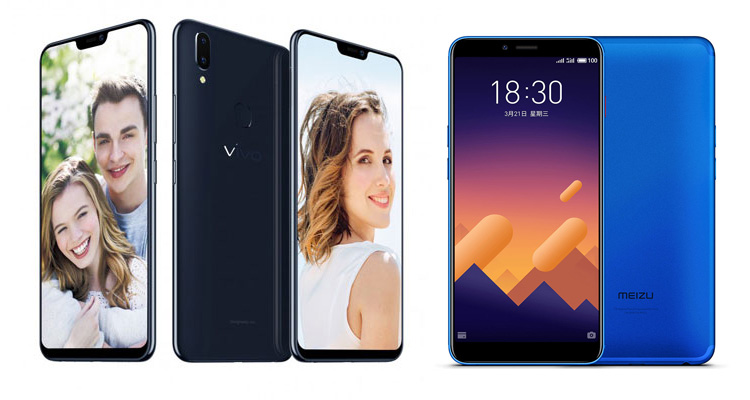These days, the mid-range smartphones sector can be divided in two categories: midrangers and the upper midrangers. The former are devices which are mostly focused on affordability (an example is the Xiaomi Redmi 5 Plus), while the latter section usually feature handsets which boast some high-end features but they are not real flagships and they cost a bit more than normal midrangers (e.g. Oppo R15 and Vivo X21).
The new Vivo V9 and Meizu E3 are two devices which I would place exactly in the middle of these two categories, so they have an incredible quality-price ratio. But which of these device are worth buying in 2018? This is a Vivo V9 vs Meizu E3 comparison that will help you to decide.

Vivo V9 vs Meizu E3
| Vivo V9 | Meizu E3 | |
|---|---|---|
| DIMENSIONS AND WEIGHT | 154.8 x 75.1 x 7.9 mm, 150 grams | 156.8 x 75 x 7.6 mm, 160 grams |
| DISPLAY | 6.3 inches, 1080 x 2280p (Full HD+), 400 ppi, 18:9 ratio, IPS LCD | 5.99 inches, 1080 x 2160p (Full HD+), 403 ppi, 18:9 ratio, LTPS LCD |
| PROCESSOR | Qualcomm Snapdragon 626, octa-core 2.2 GHz | Qualcomm Snapdragon 636, octa-core 1.8 GHz |
| MEMORY | 4 GB RAM, 64 GB, micro SD slot | 6 GB RAM, 64 GB – 6 GB RAM, 128 GB, micro SD slot |
| SOFTWARE | Android 8.1 Oreo, Funtouch OS 4.0 | Android 7.1.2 Nougat, Flyme 7 |
| CONNECTIVITY | Wi-Fi 802.11 a/b/g/n/ac, Bluetooth 4.2, GPS | Wi-Fi 802.11 b/g/n/ac, Bluetooth 5.0, GPS |
| CAMERA | Dual 16 + 5 MP f/2.0 24 MP f/2.0 front camera |
Dual 12 + 20 MP f/1.9 + f/2.6 8 MP f/2.0 front camera |
| BATTERY | 3260 mAh | 3360 mAh 20W Fast charging (mCharge 3.0) |
| ADDITIONAL FEATURES | Hybrid Dual SIM slot | Hybrid Dual SIM slot |
Among these devices, Vivo V9 is definitely the one with the best design, but I’m sure some may prefer the E3 over V9. Both have a full metal unibody design, but Vivo V9 has a tri-bezel-less front panel with an incredibly high screen-to-body ratio (85.2 percent) and an iPhone X-like notch. Meizu E3 is a classic 18:9 device, but its display should offer a better viewing quality thanks to its LTPS LCD technology and up to 85 percent NTSC color gamut.
Meizu E3 also has better hardware components: under the hood, it sports an octa-core Snapdragon 636 SoC which is newer, paired with 6 GB of RAM, so it is way more powerful than Vivo V9 and its Snapdragon 626 + 4 GB RAM configuration. When it comes to the camera department, Vivo V9 wins. Even though its 16 + 5 MP rear dual camera may not be at the same level as the 12 MP dual camera of the Meizu E3 with 2.5x lossless zoom, the 24 MP selfie camera makes the V9 a camera phone which is a lot more interesting than its opponent.
READ MORE: Vivo X21 Launched In China, Packs 6.28-Inch Display, Snapdragon 660 SoC And 6GB RAM
It also supports AI which can recognize the age, sex, skin tone, and lighting conditions when the user is about to shoot a selfie. Given that there are still no camera samples of these handsets, we still cannot tell you which one is better when it comes to rear cameras. The batteries of these phones have similar capacities and, given that both the chipsets are really power-efficient, we guess that the (long!) battery lives on a single charge will be similar as well. But Meizu E3 features an advanced fast charging technology called mCharge 3.0 which makes the battery reach 53% of charge in just 30 minutes.
Meizu E3 has been launched in China with a price tag of about $285/€231, while Vivo V9’s price in India is Rs. 22,990 (~$354). While Vivo V9 is a more interesting phone for photos and aesthetics, Meizu E3 looks a better handset for rest of the features. If not for the limited availability, the E3 would have made for a great buy at just $285 as compared to the V9.
Which one would you pick?
Vivo V9 vs Meizu E3: PRO and CONS
Vivo V9
PRO
- Amazing selfie camera
- AI-driven features
- Efficient chipset
- Android Oreo out of the box
- Nice design
CONS
- Limited availability
- Pricier than E3
Meizu E3
PRO
- Great hardware
- Good display
- Fast charging
- Nice camera
CONS
- Still Nougat
- China exclusive






